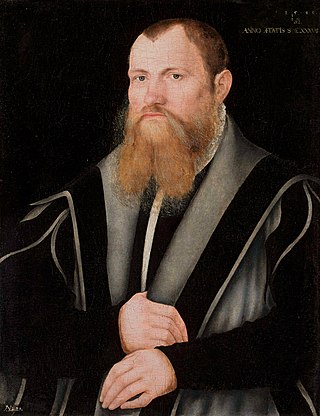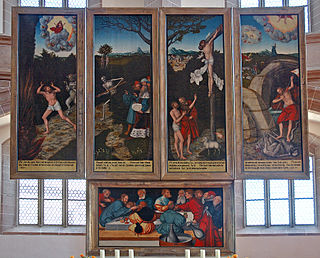
Albert of Brandenburg was a German cardinal, elector, Archbishop of Mainz from 1514 to 1545, and Archbishop of Magdeburg from 1513 to 1545.

Wittenberg, is the fourth-largest town in Saxony-Anhalt, Germany. Wittenberg is situated on the River Elbe, 60 kilometers (37 mi) north of Leipzig and 90 kilometers (56 mi) south-west of Berlin, and has a population of 46,008 (2018).

Lucas Cranach the Younger was a German Renaissance painter and portraitist, the son of Lucas Cranach the Elder and brother of Hans Cranach.

Lucas Cranach the Elder was a German Renaissance painter and printmaker in woodcut and engraving. He was court painter to the Electors of Saxony for most of his career, and is known for his portraits, both of German princes and those of the leaders of the Protestant Reformation, whose cause he embraced with enthusiasm. He was a close friend of Martin Luther. Cranach also painted religious subjects, first in the Catholic tradition, and later trying to find new ways of conveying Lutheran religious concerns in art. He continued throughout his career to paint nude subjects drawn from mythology and religion.

Christian art is sacred art which uses subjects, themes, and imagery from Christianity. Most Christian groups use or have used art to some extent, including early Christian art and architecture and Christian media.

An altarpiece is an work of art in painting, sculpture or relief representing a religious subject made for placing at the back of or behind the altar of a Christian church. Though most commonly used for a single work of art such as a painting or sculpture, or a set of them, the word can also be used of the whole ensemble behind an altar, otherwise known as a reredos, including what is often an elaborate frame for the central image or images. Altarpieces were one of the most important products of Christian art especially from the late Middle Ages to the era of Baroque painting.
The Four Apostles is a panel painting by the German Renaissance master Albrecht Dürer. It was finished in 1526, and is the last of his large works. It depicts the four apostles larger-than-life-size. The Bavarian Elector Maximilian I obtained The Four Apostles in the year 1627 due to pressure on the Nuremberg city fathers. Since then, the painting has been in Munich, in the Alte Pinakothek, and, despite all the efforts of Nuremberg since 1806, it has not been returned to Dürer's hometown.

The German Renaissance, part of the Northern Renaissance, was a cultural and artistic movement that spread among German thinkers in the 15th and 16th centuries, which developed from the Italian Renaissance. Many areas of the arts and sciences were influenced, notably by the spread of Renaissance humanism to the various German states and principalities. There were many advances made in the fields of architecture, the arts, and the sciences. Germany produced two developments that were to dominate the 16th century all over Europe: printing and the Protestant Reformation.

The Protestant Reformation during the 16th century in Europe almost entirely rejected the existing tradition of Catholic art, and very often destroyed as much of it as it could reach. A new artistic tradition developed, producing far smaller quantities of art that followed Protestant agendas and diverged drastically from the southern European tradition and the humanist art produced during the High Renaissance. The Lutheran churches, as they developed, accepted a limited role for larger works of art in churches, and also encouraged prints and book illustrations. Calvinists remained steadfastly opposed to art in churches, and suspicious of small printed images of religious subjects, though generally fully accepting secular images in their homes.

The Last Supper of Jesus and the Twelve Apostles has been a popular subject in Christian art, often as part of a cycle showing the Life of Christ. Depictions of the Last Supper in Christian art date back to early Christianity and can be seen in the Catacombs of Rome.

The Stadt- und Pfarrkirche St. Marien zu Wittenberg is the civic church of the German town of Lutherstadt Wittenberg. The reformers Martin Luther and Johannes Bugenhagen preached there and the building also saw the first celebration of the mass in German rather than Latin and the first ever distribution of the bread and wine to the congregation – it is thus considered the mother-church of the Protestant Reformation. In 1996, it was inscribed on the UNESCO World Heritage List along with Castle Church of All Saints (Schlosskirche), the Lutherhaus, the Melanchthonhaus, and Martin Luther's birth house and death house in Eisleben, because of its religious significance and testimony to the lasting, global influence of Protestantism.

Crucifixion is an oil painting by German artist Lucas Cranach the Elder. One of many versions of the subject painted by Cranach, this one, created in 1532, is now in the Indianapolis Museum of Art.

Law and Gospel is one of a number of thematically linked, allegorical panel paintings by Lucas Cranach the Elder from about 1529. The paintings, intended to illustrate Lutheran ideas of salvation, are exemplars of Lutheran Merkbilder, which were simple, didactic illustrations of Christian doctrine.

Lutheran art consists of all religious art produced for Lutherans and the Lutheran churches. This includes sculpture, painting, and architecture. Artwork in the Lutheran churches arose as a distinct marker of the faith during the Reformation era and attempted to illustrate, supplement and portray in tangible form the teachings of Lutheran theology.

Law and Grace is considered one of the most important paintings by Lucas Cranach the Elder. This work, in the collection of the National Gallery in Prague, is one of the two oldest known versions of this theme and was executed in 1529. It is also called the Prague type and provided the model for a series of other paintings including an early-16th-century copy that is also kept in the Prague National Gallery's collection of Old European art. It is the best-known and most influential allegory depicting the fundamental tenets of Luther's reform of the church.

Caritas is an oil on panel painting by German painter Lucas Cranach the Elder. The painting is kept in the Royal Museum of Fine Arts, Antwerp.

The Torgauer Altar, Torgau Altarpiece or Altarpiece of the Holy Kinship is a triptych altarpiece painted by Lucas Cranach the Elder in 1509.

The Schneeberg Altarpiece is a Lutheran winged altarpiece created in 1539 by Lucas Cranach the Elder for the Church of St. Wolfgang in Schneeberg in Saxony, Germany. The altarpiece was commissioned in 1531–1532 by the Elector of Saxony John I of Saxony and installed in the church in 1539, making it the first Protestant altarpiece of Reformation which is considered a Saxon masterpiece of art.

Weimar Cranach Altarpiece is a Lutheran winged altarpiece created by Lucas Cranach the Elder and his son Lucas Cranach the Younger between 1552 and 1555 for the Church of St. Peter und Paul in Weimar, Germany.

Wittenberg Cranach Altarpiece is one of the major Lutheran winged altarpieces created by Lucas Cranach the Elder and his son Lucas Cranach the Younger for the Evangelical Lutheran City and Parish Church of St. Mary's in Wittenberg, Germany. The altarpiece depicts the key figures of Lutheranism associated with the parish church of Wittenberg.



















